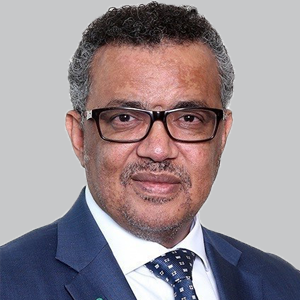News
Article
NeurologyLive
World Health Organization Adds Several MS Treatments to List of Essential Medicines
Author(s):
With the new update, cladribine, glatiramer acetate, and rituximab, are now included in the Lists of Essential Medicines, filing a gap given the global burden of multiple sclerosis.
Tedros Adhanom Ghebreyesus

The World Health Organization (WHO) published new editions of the Model Lists of Essential Medicines (EML) and Essential Medicines for Children (EMLc), which now include 3 new therapies for the treatment of multiple sclerosis. Launched in 1977 to promote better access to medicines in developing countries, the WHO Model Lists have become a global policy tool for decisions related to the selection and universal coverage of medicines within all health systems.
In a meeting of the WHO Expert Committee on the Selection and Use of Essential Medicines, held April 24-28 at the WHO Headquarters in Geneva, the committee considered and reviewed 85 applications for medicines to be added. In total, the updated EML includes 24 new medicines for adults and 12 new medicines for children for the treatment of several conditions, including MS, cancer, infectious diseases, cardiovascular conditions, and more. In addition, the update adds new formulations of 19 medicines to the EML and 48 medicines to the EMLc.
"For over 40 years, countries all over world have relied on the WHO Essential Medicines List as a definitive, evidence-based guide the most important medicines for delivering the biggest health impact," Tedros Adhanom Ghebreyesus, director-general at WHO, said in a statement. "Rising prices and supply chain disruptions mean that all countries now face increasing problems in ensuring consistent and equitable access to many quality-assured essential medicines. WHO is committed to supporting all countries to overcome these obstacles to increase access with equity."
The recommended changes bring the total number of medicines on the EML and EMLc to 502 and 361, respectively. In addition, the updated EML specified new uses for 16 already-listed medicine. For MS, cladribine, glatiramer acetate, and rituximab, 3 therapies that have shown an ability to slow or delay disease progression, were added to the EML, filling an important gap given the large global burden of MS. The decision to support ritixumab, a widely used off-label therapy, was supported by “strong evidence of its efficacy and safety for this indication,” the WHO noted.
"The List is an important tool for achieving universal health coverage, providing guidance to governments, health facilities and procurers on which medicines are the best value in terms of benefits for individuals and communities. The EML includes medicines only on the basis of solid evidence for safety and efficacy," Benedikt Huttner, secretariat of the WHO EML, said in a statement.1 "Approved indications within national jurisdictions or the availability of on-label alternatives is not a decision criterion. Given the evidence base and the increased affordability of rituximab, including the availability of prequalified biosimilars, it has been prioritized over on-label alternatives as an essential medicine to treat relapsing-remitting and progressive MS."
READ MORE: Guidelines for Differentiating Diagnosis of Suspected Multiple Sclerosis Updated
For cardiovascular diseases, fixed-dose combinations of prevention therapies for diseases of the heart and blood vessels, notably cholesterol-lowering agents with 1 or more blood pressure lowering agents with and without acetylsalicylic acid, were added to the EML for the first time. Since the previous update, scientists from multiple countries conducted milestone trials further confirming and validating the benefit of these combinations for both primary and secondary prevention of heart disease.
Several changes were made for medicines that treat infectious diseases, including the addition of ceftolozane and tazobactam, a group antibiotic effective against multi-drug resistant bacteria. Additionally, pretomanid, a therapy for multidrug-resistant or rifampicin-resistant tuberculosis, was added. Monoclonal antibodies for Ebola virus disease, as well as ravidasvir, a therapy for chronic hepatitis C virus infection in adults, were included in the updated EML.
Updates were made to listed formulations of over 70 medicines in the EMLc to ensure appropriate dosage forms and strengths for use in children aged up to 12 years. The EMLc also was expanded to include ready-to-use therapeutic food as a treatment of severe acute malnutrition in infants and children up to 5 years old.
Several applications were not recommended for the new EML and EMLc. Some of these include risdiplam (Evrysdi; Genentech) for the treatment of spinal muscular atrophy, donepezil for patients with dementia due to Alzheimer disease, CAR-T cell therapies for lymphoma, and fast-acting oral transmucosal fentanyl for breakthrough cancer pain. Ocrelizumab (Ocrevus; Genentech), the only FDA-approved therapy for progressive MS, was also not recommended.
REFERENCE
1. WHO endorses landmark public health decisions on Essential Medicines for Multiple Sclerosis. News release. World Health Organization. July 26, 2023. Accessed July 26, 2023. https://www.who.int/news/item/26-07-2023-who-endorses-landmark-public-health-decisions-on-essential-medicines-for-multiple-sclerosis





